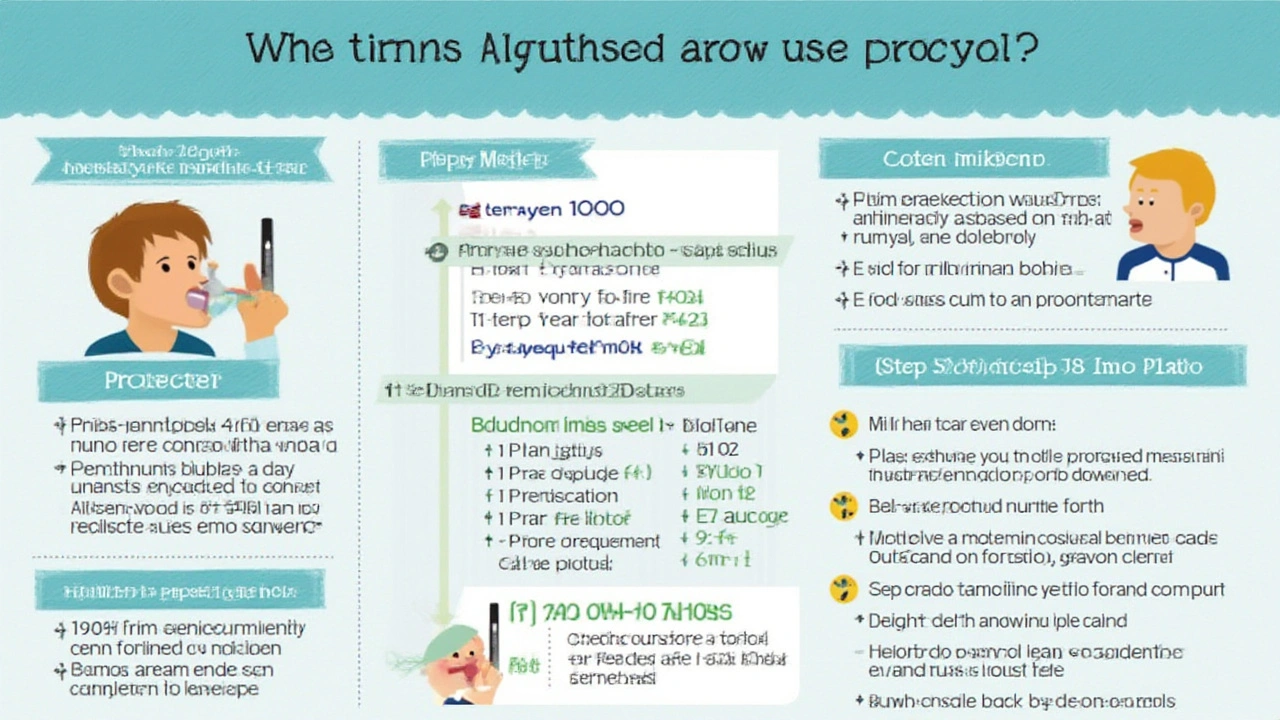If you’ve ever watched your child struggle for breath, you know how helpless that moment can feel. Asthma attacks hit hard and fast, and parents will do just about anything for relief. Right now, albuterol is the rescue inhaler given most often to kids. But is it as straightforward as doctors make it sound? With inhalers in diaper bags and classrooms, and nebulizers tucked away at grandma’s house, parents have questions that deserve straight answers. Here’s what most don’t tell you about how albuterol really works, what you need to know to keep your kid safe, and those nitpicky dosage questions that make all the difference mid-attack.
How Albuterol Works and Why Kids Need It
No babysitter, pediatrician, or school nurse wants a guessing game during an asthma attack. Albuterol’s main role? It’s what doctors call a “bronchodilator” – basically, it opens up narrow airways in minutes. That’s pure gold when your kid’s wheezing so hard they can barely say their name. Here’s the science in simple terms: During an asthma attack, muscles around the airways tighten up, and the lining swells. Air can’t get in or out easily, so every breath gets harder. Albuterol relaxes those muscles fast, letting the air flow again.
The stuff works in about 5 to 10 minutes when inhaled – that’s why it’s the go-to for emergency breathing issues, not just ongoing asthma but things like RSV, bronchiolitis, or even allergies that cause sudden wheezing. It doesn’t solve the long-term swelling (that’s what controller meds are for), but it gives your child time to recover and you a little breathing room too.
Fact: According to the CDC, nearly 4.5 million kids in the U.S. have asthma as of 2025, and almost every one of them will be prescribed albuterol at some point. But it isn’t just for older children. Infants just a few months old get it, usually through a nebulizer, because their airways are smaller and can block up faster. It’s one of those meds you want on hand—just like an EpiPen for allergies—if your child has ever wheezed during a cold or run across the yard gasping for breath.
Ever wonder why sometimes your doctor gives the inhaler and other times that noisy nebulizer machine? It’s not random. Kids under age 5, especially those under 2, often get the nebulizer because it’s easier—they can cry, nap, or squirm, and still inhale the medicine as tiny droplets in the mist. Older kids get a metered-dose inhaler (MDI), usually with a spacer. And, yes, spacers aren’t just extra plastic—they make sure the medication doesn’t get stuck in your child’s mouth or throat, actually getting into their lungs where it’s needed.
One weird fact: Albuterol was first approved in 1981, and today, it’s prescribed more than any other rescue inhaler for kids. Schools require an “asthma action plan” for students, and albuterol is the emergency item in almost every plan. Quick tip—teach your child’s teacher or babysitter exactly how your child uses their inhaler, because every kid’s technique is a bit different. Even small changes—like shaking the inhaler or waiting a few seconds between puffs—can seriously affect how much medicine gets into those tiny lungs.

Priceless Parent Tips: Albuterol Dosage, Safety, and Mistakes to Avoid
You don’t want to mess up a rescue medication. The right albuterol for children dose can mean the difference between a scary hospital visit and a smooth afternoon. Yet parents still make common mistakes—either from panic or just not being told the full story.
For inhalers, most pediatricians suggest: 1-2 puffs for kids ages 4 and above, every 4 to 6 hours as needed—but never more than every 4 hours. For nebulizers, the typical dose is 2.5 mg (in 3 mL saline), though infants and toddlers may only need half that. But dosing depends so much on your child’s age and weight—so triple check every refill or new prescription, since docs may tweak the dose over time. And keep the device clean! Inhalers and spacers get gross fast and leftover residue means your child isn't getting their full dose. Wash the chamber weekly, and air dry.
Albuterol wears off fast (usually in 4 hours). Unlike steroids or antibiotics, you can’t just “wait and see” when a kid is struggling to breathe. If you find you’re reaching for the inhaler more than twice a week (besides sports or colds), talk to your doctor about adjusting their asthma control meds—it probably means the daily preventer dose isn’t enough.
Side effects aren’t rare, but they usually aren’t dangerous. Expect some jitteriness, maybe a racing heart, shakiness, and mild headaches—kids sometimes describe it as "feeling a little like drinking an energy drink." Rarely, some get dizzy, or even have trouble sleeping if used too close to bedtime. These usually go away within 20-30 minutes. Keep an eye out for dry mouth or nausea, but if your child vomits right after a dose or has chest pain, call for help right away. If your child seems way too wired, or you need to use albuterol round the clock, it’s time to touch base with your provider.
How about school or sports? Many parents give their kid the inhaler “preemptively”—a puff before gym or after recess. That’s fine if your doctor says it’s okay, but don’t start upping the dose just because you’re nervous. More isn’t safer. In fact, an overdose can bring on seriously scary side effects: huge increases in heart rate, tremors, even a drop in potassium levels (rare but possible). Always record how often you use albuterol—on your phone, paper, whatever works for your family. It gives your doctor the right info during appointments, and if you end up at urgent care, they’ll want to know the exact number of puffs or nebulizer times.
Pro tip: Teach older kids to self-carry and self-use the inhaler responsibly, but only after you’ve practiced with the pediatrician or asthma nurse. Nothing beats a real demonstration using a placebo inhaler (just ask your doc for one). Also, be honest with grandparents, babysitters, or teachers: make sure they know what an asthma flare looks like and the step-by-step way to deliver albuterol—don’t assume they remember from having kids in the 80s.
Here’s a side-by-side comparison table for quick reference.
| Method | Typical Dose (Children 4+) | Onset Time | Key Uses | Common Side Effects |
|---|---|---|---|---|
| MDI (Inhaler + Spacer) | 1-2 puffs, every 4-6 hrs | 5-10 min | Acute wheeze, pre-exercise | Jitters, rapid heartbeat |
| Nebulizer | 2.5 mg/3 mL saline | 5-10 min | Severe symptoms, younger kids | Shakiness, mild nausea |

Asthma Action Plans and Real-World Advice for Parents
Now for the part you won’t find on the prescription label: real-life tips that save time (and sometimes panic attacks). First, every kid with asthma should have an asthma action plan—written instructions that say exactly when to use albuterol, when to call the doctor, and when to head to the ER. Ask your pediatrician for a printout and keep digital copies on your phone and with any adult responsible for your child.
Schools in most states require these plans before letting staff give medications, including inhalers. So be specific: note your child’s triggers (“colds,” “running,” “exposure to cats”), early warning signs (“cough at night,” “complains chest hurts”), and the exact dosage for their age. Make sure the nurse’s office has extra supplies, with all names and emergency numbers updated.
Got a picky or anxious child? Turn the inhaler and spacer into a game or routine—let them decorate the spacer with stickers, or use rewards for completing treatments. For younger kids who hate the mask, offer their favorite song or cartoon as a distraction. Consistency makes kids less afraid of treatment and more likely to use it right in an emergency.
Don’t skip checkups, even if asthma seems “under control.” Symptoms and needs change as kids grow. Your child might outgrow certain triggers (like viral-induced wheeze), or need a controller added when starting school or sports. The pediatrician should check inhaler technique at visits—ask them to watch your child take a dose and offer feedback. Most pharmacies will show you how to prime and clean your devices, too—just ask.
Always track how often albuterol is needed. If you’re using it more than prescribed, don’t just refill—bring it up with your provider. Overuse points to poor asthma control, and long-term misuse can actually make symptoms worse over time.
One last thing—watch expiration dates. Inhalers lose strength, and some parents keep the same one “just in case” for years. Check once a month, mark it on your calendar, and refresh the script with your doctor or pharmacy when you’re running low.
At the end of the day, no parent wants surprises with asthma. A well-taught child, clear instructions for helpers, up-to-date meds, and a bit of calm in the moment—that’s your best toolkit. Albuterol is safe and life-saving when used as directed. Keep up with your care team, follow the plan, and never be afraid to ask a question. Your child’s lungs—and your piece of mind—will thank you for it.
